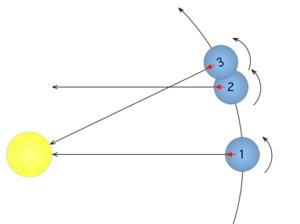Sidereal vs. Synodic Motions

1 → 3: globe repoints to sun. (synodic)
Seasonal motion of the sun comes from a combination of the rotation of the earth about its axis and the orbital revolution of the earth around the sun. A full understanding of the motions of the sun requires understanding the geometry and nature of sidereal and synodic motion.
The word sidereal derives from the Latin word for “star”. This is because sidereal motion is motion with respect to the stars. One sidereal day is the time it takes for a star in the sky to come back to the same place in the sky. Because, for all intents and purposes, the sky is “fixed”, a sidereal day is when the earth rotates 360°. A sidereal day is 23 hours 56 minutes and 4.09 seconds long.
A sidereal year is the time it takes for the sun to return to the same position with respect to the stars. Due to the precession of the equinoxes the sidereal year is about 20 minutes longer than the tropical year. The tropical year is the interval at which seasons repeat and is the basis for the calendar year.
The word synodic derives from the Greek word for meeting or assembly. It is motion relative to a conjunction or alignment of sorts. A synodic or solar day is the time it takes the sun to successively pass the meridian (astronomical noon). A mean solar day is 24 hours (the “mean” is there to average over the effect of the analemma). The earth has to rotate more than 360° for the sun to come back to “noon”.
A synodic year is the time it takes for a planet-sun alignment to reoccur. For the case of the sun, it is the time it takes the sun to come to the same place on the ecliptic (equinox to equinox) and is called a Tropical Year. A tropical year is 365.242 mean solar days (366.242 sidereal days). It is just over 20 minutes shorter than a sidereal year (again, the effect of precession).
Because a tropical year is 365.242 mean solar days long, the vernal equinox would be later and later every year if our calendar year were strictly 365 days long. In an attempt to keep the Vernal Equinox very near March 21st, the Leap Year was introduced. According to the Gregordian calendar a leap year occurs every 4 years except years evenly divisible by 100, unless that year is evenly divisible by 400. The year 1900 was not a leap year, but 2000 was.